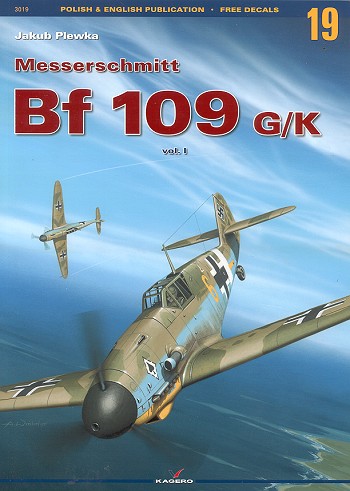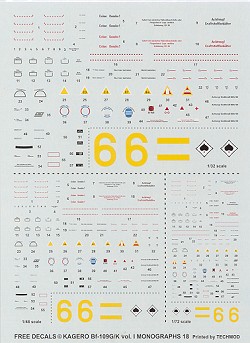 I bet you
thought that there was so much already written about the 109 that there was
nothing new to say. Well, I doubt that will ever be the case and here is
another book on the subject for you. It is #19 in Kagero's very popular
monograph series and as is so typical with an initial volume of many, this
one concentrates on describing the type and providing all the differences
that go into the variants. Things are pretty straight-forward with the 109G
until one gets into the G-6 and beyond. There, things can get a bit fuzzy
as there are G-6s which are indistinguishable from G-14 and then there are
those planes that have been reworked from earlier versions. Mix in that
there were several factories producing Bf-109s, each with some minor
differences in equipment mix and painting styles and you have what has made
the 109 such a fascinating subject for many for so long.
I bet you
thought that there was so much already written about the 109 that there was
nothing new to say. Well, I doubt that will ever be the case and here is
another book on the subject for you. It is #19 in Kagero's very popular
monograph series and as is so typical with an initial volume of many, this
one concentrates on describing the type and providing all the differences
that go into the variants. Things are pretty straight-forward with the 109G
until one gets into the G-6 and beyond. There, things can get a bit fuzzy
as there are G-6s which are indistinguishable from G-14 and then there are
those planes that have been reworked from earlier versions. Mix in that
there were several factories producing Bf-109s, each with some minor
differences in equipment mix and painting styles and you have what has made
the 109 such a fascinating subject for many for so long.
This book does a good job of helping to straighten things
out for many of us. While I learned very little that was new, I found it
nice that the author has gone away from stating that 109G-10 production was
all reconditioned airframes, as I've read in many earlier books. This time
there is the commentary on the production of the type and the differences
between Messerschmitt and Erla built machines.
 There
are the usual charts matching serials with types and where they were built,
as well as the usual excellent three views of the different versions. In
addition, one has a section that highlights the external changes between
variants; a real boon to those who are a bit fuzzy on what difference there
is in a late G-2 and early G-4. The final section is devoted to large color
profiles and color three views. As usual with a Kagero book there is an
insert. This time a decal sheet for yellow 6 that is shown on the front
cover art work and back cover three views. It is provided in the three
major scales and a full stencil suite is also on the sheet.
There
are the usual charts matching serials with types and where they were built,
as well as the usual excellent three views of the different versions. In
addition, one has a section that highlights the external changes between
variants; a real boon to those who are a bit fuzzy on what difference there
is in a late G-2 and early G-4. The final section is devoted to large color
profiles and color three views. As usual with a Kagero book there is an
insert. This time a decal sheet for yellow 6 that is shown on the front
cover art work and back cover three views. It is provided in the three
major scales and a full stencil suite is also on the sheet.
Overall, this is a very good book. 109 fans will have to
have it to add to their collections and those who'd like the confusion over
sub-types to be clarified will find this one most useful. I can highly
recommend this one.
November 2005
You can find this book and many others at

If you would like your product reviewed fairly and quickly by a
site that has nearly 300,000 visitors a month, please contact
me or see other details in the Note to
Contributors.
 I bet you
thought that there was so much already written about the 109 that there was
nothing new to say. Well, I doubt that will ever be the case and here is
another book on the subject for you. It is #19 in Kagero's very popular
monograph series and as is so typical with an initial volume of many, this
one concentrates on describing the type and providing all the differences
that go into the variants. Things are pretty straight-forward with the 109G
until one gets into the G-6 and beyond. There, things can get a bit fuzzy
as there are G-6s which are indistinguishable from G-14 and then there are
those planes that have been reworked from earlier versions. Mix in that
there were several factories producing Bf-109s, each with some minor
differences in equipment mix and painting styles and you have what has made
the 109 such a fascinating subject for many for so long.
I bet you
thought that there was so much already written about the 109 that there was
nothing new to say. Well, I doubt that will ever be the case and here is
another book on the subject for you. It is #19 in Kagero's very popular
monograph series and as is so typical with an initial volume of many, this
one concentrates on describing the type and providing all the differences
that go into the variants. Things are pretty straight-forward with the 109G
until one gets into the G-6 and beyond. There, things can get a bit fuzzy
as there are G-6s which are indistinguishable from G-14 and then there are
those planes that have been reworked from earlier versions. Mix in that
there were several factories producing Bf-109s, each with some minor
differences in equipment mix and painting styles and you have what has made
the 109 such a fascinating subject for many for so long. There
are the usual charts matching serials with types and where they were built,
as well as the usual excellent three views of the different versions. In
addition, one has a section that highlights the external changes between
variants; a real boon to those who are a bit fuzzy on what difference there
is in a late G-2 and early G-4. The final section is devoted to large color
profiles and color three views. As usual with a Kagero book there is an
insert. This time a decal sheet for yellow 6 that is shown on the front
cover art work and back cover three views. It is provided in the three
major scales and a full stencil suite is also on the sheet.
There
are the usual charts matching serials with types and where they were built,
as well as the usual excellent three views of the different versions. In
addition, one has a section that highlights the external changes between
variants; a real boon to those who are a bit fuzzy on what difference there
is in a late G-2 and early G-4. The final section is devoted to large color
profiles and color three views. As usual with a Kagero book there is an
insert. This time a decal sheet for yellow 6 that is shown on the front
cover art work and back cover three views. It is provided in the three
major scales and a full stencil suite is also on the sheet.